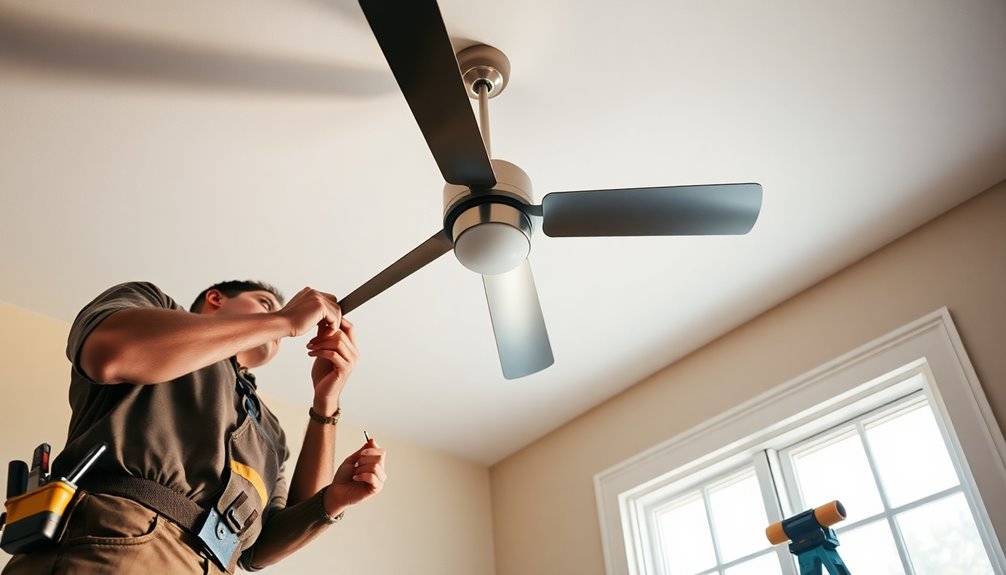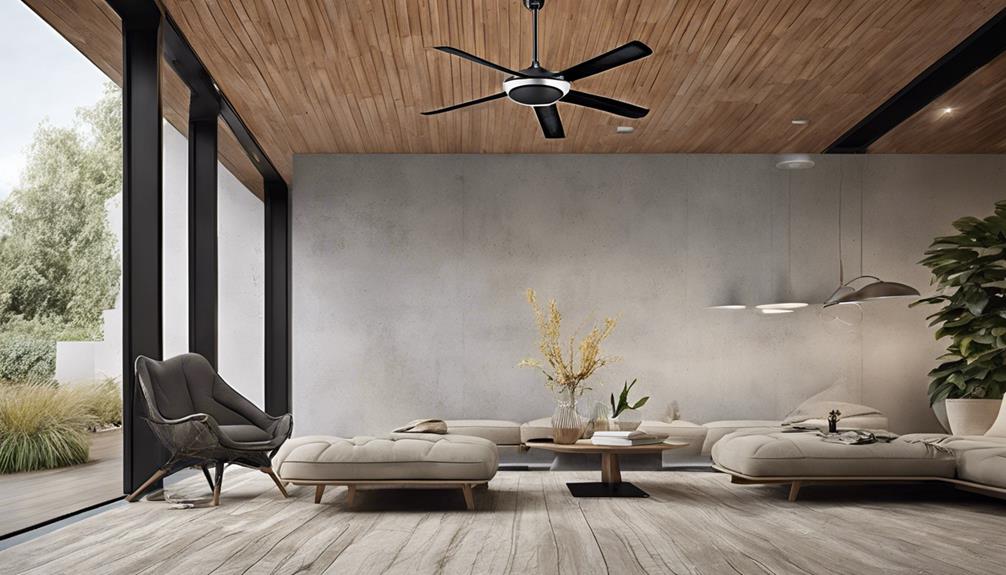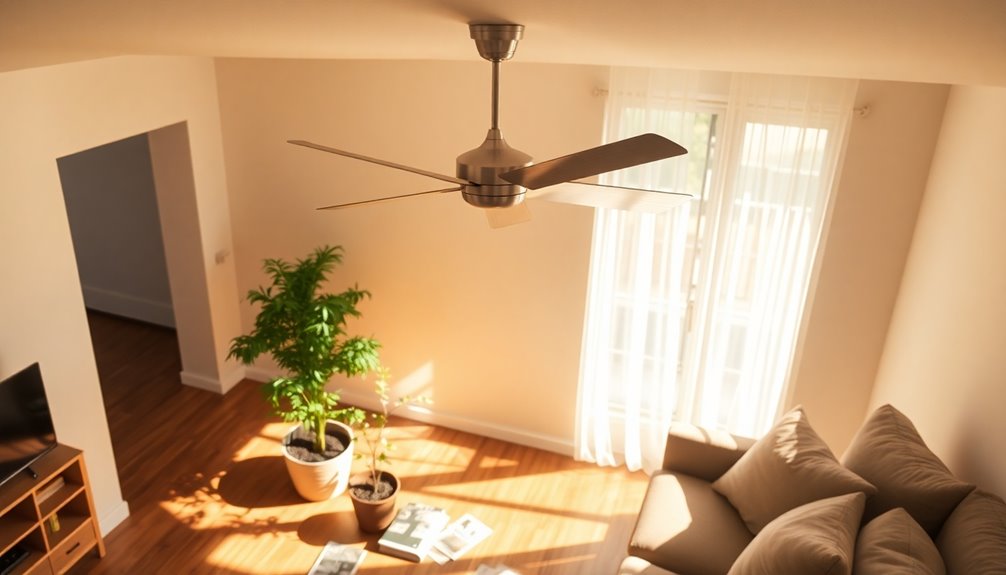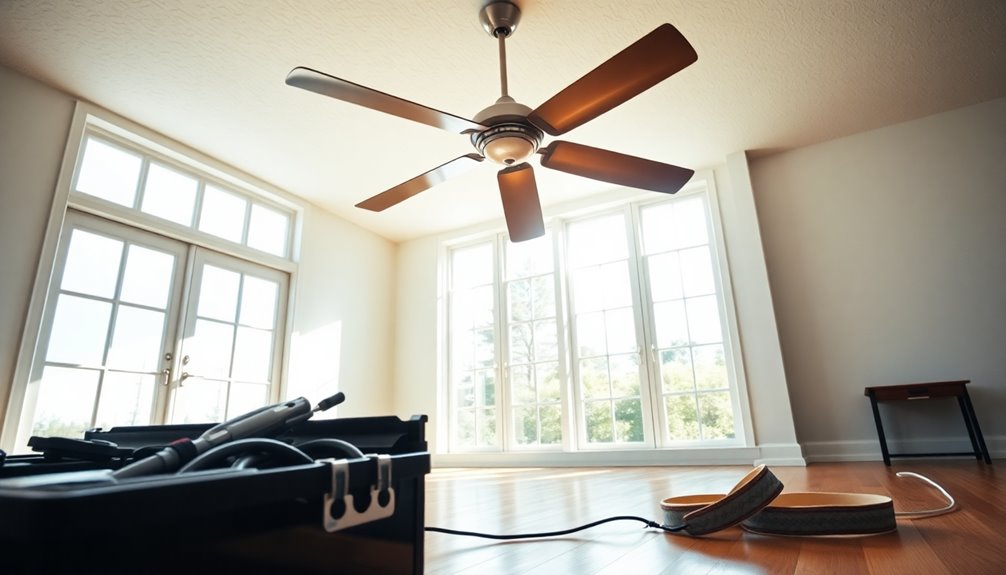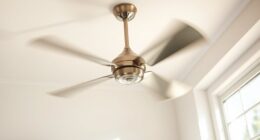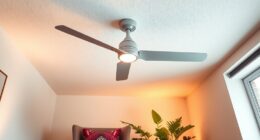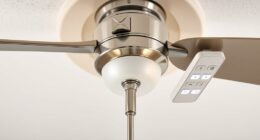Ceiling fans are definitely worth it for enhancing your home's comfort and efficiency. They're budget-friendly, operating for about 1 cent per hour, and can reduce cooling costs by up to 30% when paired with air conditioning. With modern designs, smart technology, and energy-efficient features, you can enjoy better airflow and stylish decor at the same time. Plus, they help improve indoor air quality by preventing stagnant air. Maintenance is low-cost and simple, making them a smart choice for long-term savings. If you're intrigued by all the benefits they offer, you'll find even more insights ahead.
Key Takeaways
- Ceiling fans significantly reduce energy consumption, lowering cooling costs by up to 30% when used with air conditioning.
- They offer a budget-friendly alternative to air conditioning, with operating costs around 1 cent per hour.
- Modern ceiling fans feature energy-efficient LED lighting and advanced technologies for enhanced convenience and efficiency.
- Aesthetic appeal and diverse designs make ceiling fans a stylish addition to any room's decor.
- Regular maintenance ensures optimal performance and extends the lifespan of ceiling fans, making them a worthwhile investment.
Historical Context of Ceiling Fans

Ceiling fans have a fascinating history that stretches back to ancient times. In the Roman Empire, wealthy households employed servants to fan air for comfort, showcasing the early desire for a cooler indoor environment.
Fast forward to 17th century India, where the first known ceiling fans, called punkah, emerged. These fans were crafted from palm leaves and operated manually by ropes, emphasizing the ingenuity of that era.
By the Civil War era, American buildings began featuring fans powered by water or steam, marking a significant advancement in cooling technology. This evolution continued when Phillip Diehl invented the electric ceiling fan in 1882, revolutionizing indoor comfort and making these essential appliances widely accessible.
As you explore the historical context, you'll see how ceiling fans come to enhance homes aesthetic, blending functionality with style.
Throughout the 20th century, designs progressed from rudimentary two-blade models to more efficient five-blade versions by World War I. This evolution reflects not just technological advancement but also changing tastes in home decor.
Understanding this rich history can deepen your appreciation for the ceiling fan's role in both comfort and aesthetic appeal in modern homes.
Modern Features of Ceiling Fans
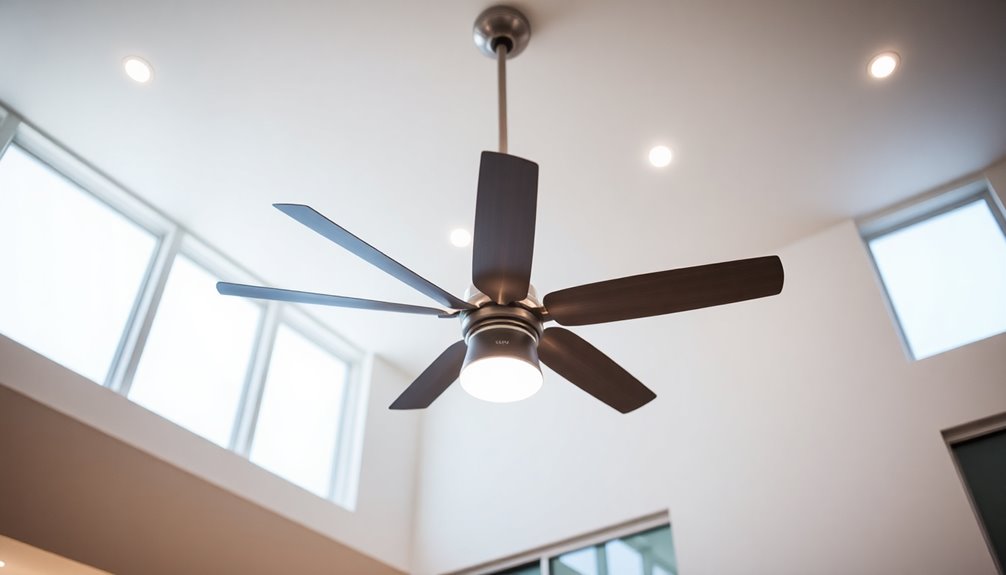
With the rise of technology and design innovation, modern ceiling fans have transformed into multifunctional appliances that enhance both comfort and style in your home.
These fans often incorporate smart technology, allowing you to control them effortlessly through voice commands with systems like Alexa and Google Home, or via smartphone apps. This convenience makes managing your environment easier than ever.
Many contemporary ceiling fans come equipped with energy-efficient LED lighting, providing ideal illumination while using less energy.
Additionally, advanced models utilize DC motors, which can be up to 70% more energy-efficient than traditional AC motors. This results in significant energy savings on your electricity bills.
You can even program smart ceiling fans to create custom schedules, maximizing airflow and cooling in your living space. By doing so, you could potentially save up to 30% on energy costs.
Finally, modern ceiling fans don't skimp on style. They offer a range of designs, from sleek and minimalist to bold statement pieces, ensuring that they'll complement your home's decor beautifully.
Embracing these innovative features can elevate your living experience while keeping your energy expenses in check.
Energy Efficiency Benefits

When you choose ceiling fans, you're making a smart move for energy efficiency. These fans lower energy consumption considerably and can enhance your HVAC system's performance, leading to cost savings over time. Additionally, energy-efficient technology can further optimize your overall energy use and reduce your carbon footprint. Furthermore, using ceiling fans in conjunction with heat pumps can improve indoor air quality by promoting better airflow and circulation.
Lower Energy Consumption
While air conditioning can be a significant expense during hot months, ceiling fans offer a budget-friendly alternative that can dramatically cut cooling costs. Operating a ceiling fan costs about 1 cent per hour, making it a highly cost-effective cooling solution compared to air conditioning units.
If you opt for Energy Star certified ceiling fans, you'll benefit from models that are 60% more efficient than traditional ones, further reducing your energy consumption.
By using ceiling fans, you can comfortably raise your thermostat settings by up to 4 degrees, which can lead to substantial savings on your cooling bills.
Modern ceiling fans equipped with DC motors consume up to 70% less energy than conventional AC motors, enhancing their efficiency even more.
If you use ceiling fans alongside your air conditioning, you could lower your cooling costs by up to 30% by improving air circulation and distribution throughout your home.
Enhanced HVAC Efficiency
Ceiling fans can greatly enhance the efficiency of your HVAC system, ensuring you stay comfortable without overworking your air conditioner. By circulating air effectively, ceiling fans can lower the perceived temperature in a room by up to 8 degrees Fahrenheit. This means you can set your thermostat higher without sacrificing comfort, which helps in reducing energy consumption.
Combining ceiling fans with your air conditioning can lead to significant energy savings, allowing you to adjust your thermostat up to 4 degrees higher. This simple adjustment can reduce the need for cooling by enhancing performance and potentially lowering your energy bills by as much as 30%.
Moreover, if you choose Energy Star certified ceiling fans, you're opting for models that are up to 60% more efficient than traditional ones.
Modern ceiling fans with DC motors are also a great choice, as they consume up to 70% less energy than older AC motor designs. This means you can enjoy a cooler environment while being mindful of your energy use, making ceiling fans a smart investment for enhancing your HVAC system's efficiency.
Cost Savings Over Time
How much could you save on your energy bills by using ceiling fans? The answer might surprise you. Ceiling fans can reduce energy consumption by up to 40% in summer and 10% in winter, translating to significant cost savings on your utility bills.
Running a ceiling fan costs around 1 cent per hour, making it a much cheaper option compared to air conditioning systems, which can drain your budget. Additionally, using ceiling fans can enhance the overall efficiency of your home's heating and cooling systems, leading to further savings over time.
When you pair ceiling fans with smart thermostats, you could save up to 30% on cooling bills. These fans allow you to adjust your thermostat by up to 4 degrees higher without sacrificing comfort, further decreasing reliance on air conditioning. This means you can enjoy a comfortable living space while keeping those energy costs in check.
Don't forget about Energy Star certified ceiling fans. These models are 60% more efficient than conventional fans, enhancing your cost-saving potential over time. Additionally, increased fan efficiency leads to lower energy bills, making them an even smarter investment for your home.
By investing in ceiling fans, you're not just improving comfort; you're also making a smart financial choice that promotes energy efficiency and long-term savings.
Aesthetic Appeal and Design

When you choose a ceiling fan, you're not just selecting a functional piece; you're enhancing your interior decor with stylish design options.
With a range of finishes and innovative styles, from sleek and minimalist to bold single-blade designs, these fans can truly elevate your space.
A well-chosen ceiling fan can become a striking focal point that ties your room together beautifully. Additionally, high-end ceiling fans often feature advanced technology integration that can further enhance both functionality and style.
Stylish Design Options
Enhancing your home's aesthetic appeal is easy with contemporary ceiling fans that offer stylish design options. You can find a wide variety of fans that cater to your personal taste and complement your decor. Sleek, minimalist designs work beautifully in modern spaces, while options like industrial chic or nautical themes allow you to express your unique style.
Brands like Big Ass Fans focus on quality materials such as metal and glass, creating eye-catching pieces that serve as focal points in any room. Many of these fans also incorporate LED lighting, adding both stylish illumination and energy efficiency to your space. This multifunctional design element can elevate a room's look while keeping your energy costs down.
Innovative designs, like single-blade options, not only enhance visual appeal but also promote quieter operation and improved efficiency. By choosing a ceiling fan that aligns with your aesthetic preferences, you can seamlessly blend functionality with style.
Enhance Interior Decor
Ceiling fans can considerably elevate your interior decor while providing much-needed functionality. With a wide variety of styles, colors, and materials, you can easily select ceiling fans that perfectly complement your space. Whether you prefer sleek, modern designs or bold statements, there's a fan to enhance your interior decor. Additionally, many models boast high CFM ratings for effective airflow, ensuring both comfort and style. Decluttering spaces can further enhance the visual appeal of your room, allowing your ceiling fan to stand out as a focal point.
Here's a quick comparison of some popular ceiling fan styles:
| Style | Features | Best For |
|---|---|---|
| Modern Minimalist | Sleek lines, energy-efficient LEDs | Contemporary spaces |
| Rustic Wood | Natural materials, warm tones | Farmhouse aesthetics |
| Industrial Chic | Metal and glass, bold designs | Urban lofts |
High-end brands, like Big Ass Fans, utilize premium materials that not only improve functionality but also serve as striking design elements. Many modern ceiling fans now incorporate energy-efficient LED lighting, adding to their aesthetic appeal. Innovative designs, such as single-blade options, can act as a centerpiece, making a statement in any room. Additionally, the use of natural elements in your decor can enhance the overall ambiance of your space.
Incorporating ceiling fans into your home is not just about comfort; it's also a fantastic way to enhance your interior decor.
Cost-Effectiveness Analysis

Investing in a ceiling fan can be a savvy move for budget-conscious homeowners looking to cut cooling costs.
With prices ranging from $50 to $300, ceiling fans offer a budget-friendly alternative to expensive air conditioning systems.
When you consider that running a ceiling fan costs approximately 1 cent per hour, it's clear that these devices are much more cost-effective than traditional air conditioning units.
Ceiling fans can lower the perceived room temperature by up to 8 degrees, allowing you to adjust your thermostat and further save on cooling bills during warmer months.
If you opt for energy-efficient models, especially those with DC motors, you can enjoy up to 70% less energy consumption compared to older fans with AC motors.
This efficiency leads to significant long-term savings. Additionally, using ceiling fans in conjunction with air conditioning can enhance energy efficiency and further reduce your overall cooling expenses.
Consumer Preferences and Usage

When it comes to comfort in your home, ceiling fans play an essential role in enhancing air circulation and temperature control. Many homeowners appreciate the ability to raise thermostat settings without sacrificing comfort. A survey revealed that 75% of homeowners consider ceiling fans a valuable addition, especially in warmer climates where improved air circulation is vital.
Using ceiling fans can reduce reliance on air conditioning by up to 30%, leading to noticeable savings on energy bills. This not only benefits your wallet but also promotes a more sustainable lifestyle. Additionally, ceiling fans can help improve indoor air quality, making them a valuable addition to any home environment.
| Preference | Percentage | Key Features |
|---|---|---|
| Value in living spaces | 75% | Enhanced comfort |
| Energy savings | Up to 30% | Reduced AC reliance |
| Aesthetic appeal | Varies | Wide variety of styles |
| Smart technology features | 60% | Remote control & voice integration |
Moreover, around 60% of consumers lean towards ceiling fans with smart technology, reflecting a trend toward convenience in home environments. With various styles available, ceiling fans not only elevate comfort but also complement your home decor effortlessly.
Maintenance and Upkeep Requirements

To keep your ceiling fan running smoothly and efficiently, regular maintenance is a must. Dust builds up on the blades, which can greatly hinder your fan's efficiency. To combat this, clean the blades every few months. A simple wipe-down with a damp cloth can make a big difference in performance.
You should also check the fan's mounting and installation periodically. Loose fans can pose safety hazards, so verify everything is securely fastened. This step not only prevents accidents but also maintains the fan's effectiveness.
If your ceiling fan has integrated lighting, consider replacing the bulbs as needed. Upgrading to energy-efficient LED bulbs can enhance your lighting's overall effectiveness while reducing energy consumption.
Lastly, routine electrical checks are vital for keeping the motor functioning properly. Regular inspections can help you spot potential issues before they become costly repairs, extending the lifespan of your ceiling fan.
Comparison With Air Conditioning
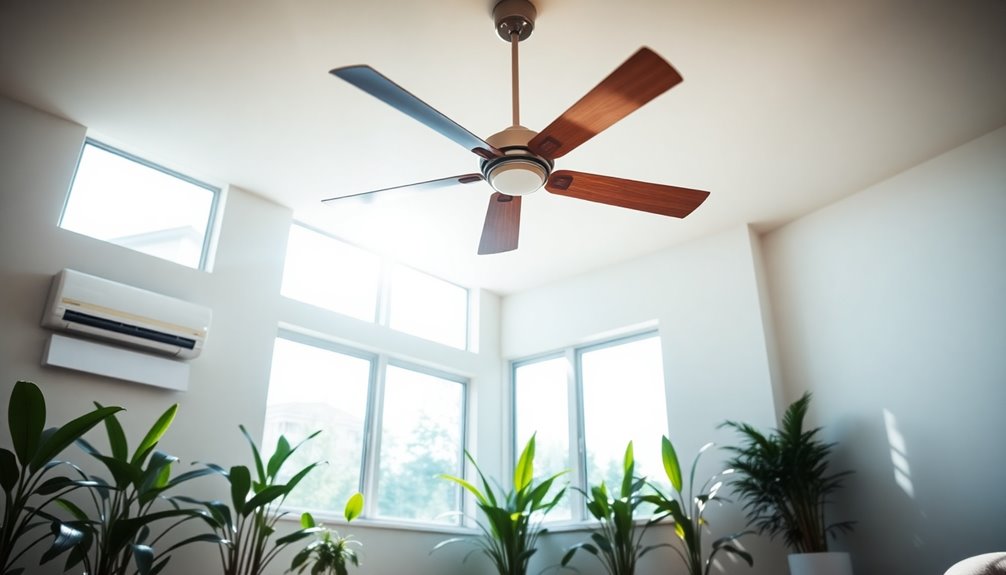
How do ceiling fans stack up against air conditioning concerning efficiency and cost? When it comes to energy consumption, ceiling fans are a clear winner. They operate at around 1 cent per hour, while air conditioning units can greatly increase your energy bills.
By using a ceiling fan, you can often raise your thermostat setting by up to 4 degrees without feeling uncomfortable, which can lead to substantial savings during hot months. Ceiling fans can even reduce your reliance on air conditioning by up to 30%, making them a cost-effective solution for keeping your indoor space comfortable.
Modern ceiling fans with energy-efficient DC motors use up to 70% less energy than older air conditioning systems, adding to their appeal. While air conditioning lowers a room's temperature, ceiling fans create a wind-chill effect that makes you feel cooler without changing the actual temperature.
This ability helps optimize your HVAC system's efficiency, allowing you to enjoy comfort without breaking the bank. To sum up, ceiling fans can be a smart, affordable alternative to air conditioning, especially during warmer months.
Market Trends and Popularity

Ceiling fans are increasingly becoming a staple in modern homes, thanks to their blend of energy efficiency and stylish designs. With advancements in technology, today's ceiling fans are up to 60% more efficient than traditional models. This surge in energy efficiency makes them an attractive option for homeowners looking to cut costs on electricity bills.
The market for ceiling fans is expanding rapidly, driven by consumer demand for smart home integration features like Wi-Fi connectivity and voice control. These modern conveniences enhance your home's functionality while providing comfort and style.
Additionally, the wide array of contemporary designs caters to various aesthetic preferences, making ceiling fans a sought-after choice for home improvement projects.
Energy Star certified ceiling fans stand out, offering potential savings that can reduce cooling costs by up to 30%. With average prices ranging from $50 to $300, these fans are a cost-effective upgrade, delivering long-term savings.
Frequently Asked Questions
Are Ceiling Fans Actually Useful?
Absolutely, ceiling fans are quite useful! They can make your space feel cooler, allowing you to raise your thermostat and save on energy bills.
With modern designs, they're energy-efficient, costing only about a cent per hour to run.
Plus, many come with integrated LED lighting, adding functionality to your decor.
If you opt for a smart model, you can control it easily with your smartphone or voice commands, enhancing your home's convenience.
What Are the Disadvantages of a Ceiling Fan?
Imagine a charming garden filled with vibrant flowers; yet, some weeds creep in, threatening its beauty.
Similarly, ceiling fans come with disadvantages. You'll notice they can produce noise, disrupting your peaceful evenings. Their lighting mightn't meet your needs, and cleaning them can feel like an uphill battle.
If installed incorrectly, safety hazards loom, and not every design will harmonize with your home's decor, leaving you with an aesthetic mismatch.
Do Ceiling Fans Add Value to a Home?
Yes, ceiling fans can add value to your home. They not only enhance energy efficiency but also help you save on cooling costs during hot months.
When you strategically place them, they improve airflow and comfort, making your living space more appealing. Plus, modern designs can elevate your home's aesthetic, attracting potential buyers.
With eco-consciousness on the rise, energy-efficient ceiling fans can make your property more desirable in a competitive market.
Do Ceiling Fans Really Cool a Room?
Ceiling fans don't actually cool a room by lowering the temperature; instead, they create a wind-chill effect that makes you feel cooler.
When they circulate air, they help evaporate moisture from your skin, enhancing comfort.
You can strategically use ceiling fans to raise your thermostat settings without losing that cool feeling, ultimately saving on energy costs.
Just remember to adjust the fan's rotation for the season to maximize its benefits.
Conclusion
In the dance of comfort and style, ceiling fans twirl gracefully through your home, blending efficiency with elegance. They whisper a cool breeze, cutting energy costs while enhancing your space's aesthetic charm. With their low maintenance and high versatility, these fans are more than just a fixture—they're a smart investment. So, as you weigh your options, remember: ceiling fans can be the gentle wind beneath your wings, making every room a sanctuary of comfort.

